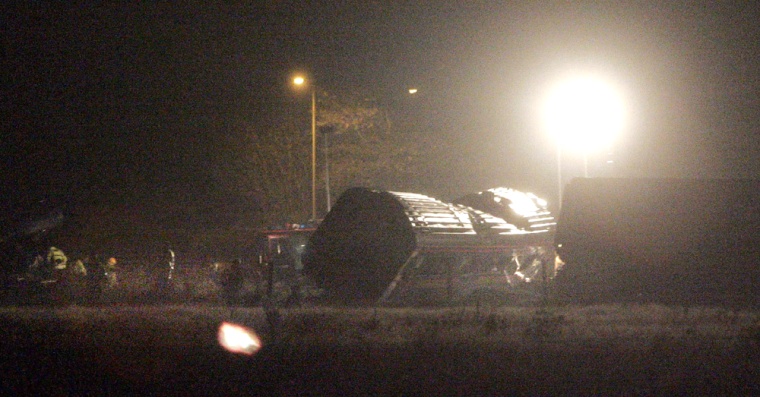A high-speed train crash which killed seven people and injured scores more in southern England may have been caused by a car driver committing suicide, British police said on Monday.
The train, carrying 300 passengers, rammed into a car at a rail crossing and flew off the rails near the village of Ufton Nervet, 40 miles west of London on Saturday.
Deputy Chief Constable Andy Trotter of British Transport Police said he was looking at the possibility that the driver of the car, which was seen parked on the crossing just before the crash, may have wanted to kill himself.
“It’s one of our lines of inquiry, obviously, given the actions of the car driver, given the fact that he was stationary on the crossing — that leads us to think it may have been a deliberate action,” Trotter told BBC radio.
He said police were also investigating the possibility of mechanical faults with the car or the crossing, but said there was no indication at this stage of any defect with the crossing.
Trotter said an off-duty police officer had spotted the car sitting stationary on the rural crossing with the road barrier up moments before the high-speed crash.
The barrier then came down and the police officer rushed to the emergency phone. But before he could get any response a train came through and hit the car.
He denied media reports that the driver had told the off-duty officer “I want to die” before the crash.
Rail analysts said the train would have been travelling at 100 mph as it approached the crossing and passengers said it braked hard just before the collision.
Six people died in the crash and another died in hospital on Sunday from injuries sustained. One of the dead was the driver of the car. Up to 18 passengers remained in hospital, four in a serious but stable condition.
Train operator First Great Western, a subsidiary of FirstGroup Plc, said the train driver was among the dead.
The company released a statement on Monday expressing shock and sadness at the crash. It said it would do everything possible to minimize further disruption to travelers.
Trotter said it would be several days before the remains of the twisted carriages could be lifted from the tracks. He said the last two bodies were removed from the scene on Sunday.
“It’s a pretty dreadful scene,” he said. “It is quite remarkable the scale of the damage to the train and to the tracks from this event. It is a shocking and pretty awful site.”
A political issue in Britain
There was no indication that infrastructure failure or railway staff were responsible for the crash, in a country where rail safety has been a political issue since a series of deadly crashes followed the industry’s privatization in the 1990s.
Britain’s biggest rail union RMT called for the elimination of level crossings on high-speed rail lines.
Anthony Smith, director of the Rail Passengers Council, said it was crucial a thorough investigation was carried out.
“There are two big questions which need answering quickly — what was the car doing on the railway line and why did the train derail in such a catastrophic fashion?” he said.
Rail crashes blamed on shoddy maintenance and poor driver training over the past five years have killed 42 people.
